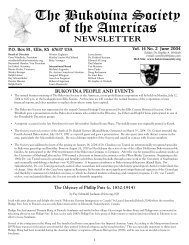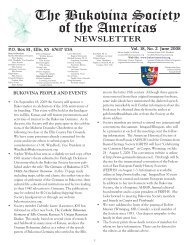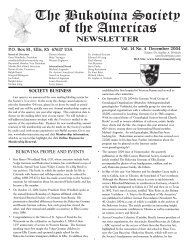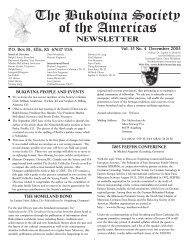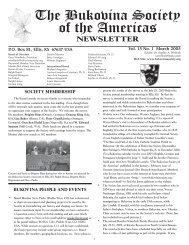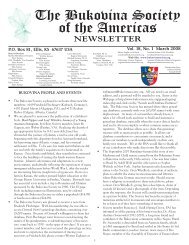March 2004 Vol. 14 #1 - Bukovina Society of the Americas
March 2004 Vol. 14 #1 - Bukovina Society of the Americas
March 2004 Vol. 14 #1 - Bukovina Society of the Americas
Create successful ePaper yourself
Turn your PDF publications into a flip-book with our unique Google optimized e-Paper software.
communities <strong>of</strong> Killaly and Grayson wherein settled <strong>the</strong> Appel,<br />
Batza, Baumgartner, Duczek, Fuchs, Gelowitz, Hicke, Huber,<br />
Kopetski, Lichtenwald, Ludwar, Ruehr, Stadecki, Zaleski and<br />
Zimmer families, who continued to immigrate from <strong>Bukovina</strong>. By<br />
1904 most <strong>of</strong> <strong>the</strong> available homestead land in <strong>the</strong>se areas was<br />
occupied, leading <strong>the</strong> sons <strong>of</strong> <strong>the</strong> original settlers and <strong>the</strong> new<br />
immigrants to move on to Spring Valley, Claybank and Bayard.<br />
Shortly after <strong>the</strong> first settlers arrived, <strong>the</strong>y approached Archbishop<br />
Adelard Langevin <strong>of</strong> St. Boniface, Manitoba, to ask that a priest visit<br />
<strong>the</strong>ir community. Until construction <strong>of</strong> <strong>the</strong> chapel at Mariahilf in<br />
1900 <strong>the</strong> priest conducted monthly services in <strong>the</strong> homes <strong>of</strong> <strong>the</strong><br />
parishioners. In 1907 St. Mary’s Church was built in Grayson<br />
followed in 1910 by St. Elizabeth’s Church in Killaly. Until <strong>the</strong><br />
completion <strong>of</strong> <strong>the</strong> Lu<strong>the</strong>ran church in Killaly (1926), <strong>the</strong> Lu<strong>the</strong>rans<br />
likewise held religious services in private homes and schools. Church<br />
records for all <strong>the</strong>se parishes are extant and where needed, new<br />
markers have been placed on many <strong>of</strong> <strong>the</strong> “unknown” graves to<br />
memorialize <strong>the</strong> names <strong>of</strong> <strong>the</strong>se early pioneers.<br />
The settlers valued education. No sooner had <strong>the</strong> families established<br />
<strong>the</strong>ir communities than <strong>the</strong>y requested permission to set up<br />
school districts. Until <strong>the</strong> outbreak <strong>of</strong> <strong>the</strong> First World War many <strong>of</strong><br />
<strong>the</strong> schools used German as <strong>the</strong> language <strong>of</strong> instruction.<br />
Communication among <strong>the</strong> settlers was facilitated through <strong>the</strong><br />
Saskatchewan Courier, a German-language newspaper published in<br />
Regina from 1907. Through letters to <strong>the</strong> editor <strong>the</strong>y carried on<br />
lively debates about current agricultural practices and politics. Each<br />
community usually had a column, which noted local happenings.<br />
Issues <strong>of</strong> <strong>the</strong> newspaper have been micr<strong>of</strong>ilmed and are available to<br />
anyone interested in reading about <strong>the</strong> lives <strong>of</strong> <strong>the</strong>se early settlers.<br />
While in Canada <strong>the</strong>re is no formal association <strong>of</strong> <strong>the</strong> descendants <strong>of</strong><br />
<strong>the</strong> Germans from <strong>Bukovina</strong>, <strong>the</strong>re are many opportunities to learn<br />
more about genealogy, culture, history and traditions relating to<br />
<strong>Bukovina</strong> and Bukovinians. Mention might here be made <strong>of</strong> <strong>the</strong><br />
<strong>Bukovina</strong> <strong>Society</strong> <strong>of</strong> <strong>the</strong> <strong>Americas</strong> at P. O. Box 1083, Hays, KS<br />
67601, USA and to its web site at http://www.bukovinasociety.org><br />
Those who read German may wish to check with <strong>the</strong><br />
Landsmannschaft der Buchenlanddeutschen or <strong>the</strong> Bukowina Institut,<br />
both at Alter Postweg 97a, 86159 Augsburg, Germany or <strong>the</strong>ir email<br />
address at bukinst@t-online.de> There is also <strong>the</strong> <strong>Bukovina</strong><br />
Genealogy List at buko-gen.html which <strong>of</strong>fers subscribers an<br />
opportunity to ask questions, exchange views, and enter into a dialog<br />
with like-minded Bukovinian researchers on a global scale. Many<br />
descendants <strong>of</strong> <strong>the</strong> first Bukovinian immigrants to Canada are<br />
continuing <strong>the</strong>ir association with <strong>Bukovina</strong> ei<strong>the</strong>r through visits to<br />
<strong>the</strong>ir ancestral villages, through genealogical research or through <strong>the</strong><br />
internet.<br />
Right here at home <strong>the</strong> Saskatchewan Genealogical <strong>Society</strong> (SGS)<br />
<strong>of</strong>fers programs in genealogical research using <strong>the</strong> resources <strong>of</strong> <strong>the</strong><br />
SGS Library, which includes maps, histories and actual church<br />
records for Bukovinian communities. Many individuals have<br />
completed extensive histories about <strong>the</strong>ir families and have deposited<br />
copies in <strong>the</strong> library. In addition, Saskculture at http://<br />
www.Saskculture.sk.ca> serves as an umbrella organization for <strong>the</strong><br />
many diverse cultural groups in Saskatchewan. One such group is<br />
<strong>the</strong> Saskatchewan German Council http://saskgermancouncil.org><br />
which works to promote and preserve culture, language, customs,<br />
4<br />
traditions and interests <strong>of</strong> Saskatchewans <strong>of</strong> German-speaking<br />
backgrounds. Those willing to expend <strong>the</strong> effort will undoubtedly<br />
find <strong>the</strong> resources to enrich <strong>the</strong>ir knowledge <strong>of</strong> <strong>Bukovina</strong> and its<br />
people.<br />
*The author is a certified Saskatchewan Researcher and Educational<br />
Coordinator <strong>of</strong> <strong>the</strong> Saskatchewan Genealogical <strong>Society</strong> (SGS). The<br />
article presented here has been reprinted from SGS Bulletin, vol. 34<br />
(June 2003): 43-45. It appeared in German translation in Der<br />
Südostdeutsche (Augsburg), June 20, 2003, pp. 1, 8.<br />
KARL FLACHS<br />
IN MEMORIUM<br />
by Al Lang (Sycamore, IL)<br />
When I heard <strong>of</strong> <strong>the</strong> passing <strong>of</strong><br />
Karl Flachs, I was deeply saddened,<br />
as I had not only lost a<br />
relative but also a very dear friend.<br />
Born on July 7, 1923 in <strong>the</strong><br />
German-Bohemian village <strong>of</strong><br />
Pojana Mikuli (aka Buchenhain), <strong>Bukovina</strong>, Karl experienced in full<br />
measure <strong>the</strong> poignancy <strong>of</strong> resettlement, flight and expulsion, which<br />
befell <strong>the</strong> <strong>Bukovina</strong> Germans in <strong>the</strong> wake <strong>of</strong> World War II. His final<br />
years were spent in Waldkraiburg, Germany, where he died on<br />
November 21, 2003.<br />
I vividly recall my first meeting with Karl, at which a mutual<br />
relative, using <strong>the</strong> German-Bohemian dialect, introduced me as<br />
follows: “Karl, kennst du no’ den Lang Ignaz. Er ist von dem Lang, a’<br />
Bua, no’ a’ Bua, und no’ amol a’ Bua.” (Karl, you still remember<br />
Ignaz Lang. Of Ignatz he is a son, yet ano<strong>the</strong>r son, and <strong>the</strong>n yet<br />
ano<strong>the</strong>r son.), i.e., he is <strong>the</strong> great-grandson <strong>of</strong> Ignaz Lang. At that<br />
moment Karl and I bonded through common language, tradition and<br />
genealogy.<br />
A truly genuine and honest man, Karl welcomed everyone as a<br />
friend. With me he shared <strong>the</strong> fact that he <strong>of</strong>ten thought fondly <strong>of</strong><br />
his relatives in Brazil and in <strong>the</strong> United States, although he lamented<br />
<strong>the</strong> Americanization <strong>of</strong> <strong>the</strong> family name to Flax. It also<br />
disturbed him that World War II had pitted family against family on<br />
<strong>the</strong> battlefield.<br />
Karl confirmed stories I had heard about <strong>Bukovina</strong> as a child;<br />
moreover, he seemed surprised and pleased that <strong>the</strong>se stories had<br />
survived three generations in America. We exchanged folklore<br />
including tales <strong>of</strong> ghosts and goblins. But most importantly we spent<br />
many hours pouring over his voluminous genealogical documents<br />
including Ahnenpässe (genealogical charts issued for payment to<br />
Bukovinians who resettled in Germany in 1940). I vividly recall<br />
Karl’s passion for accuracy. When he discovered an error in an<br />
Ahnenpass, he vociferously expressed his frustration at <strong>the</strong> money<br />
spent in vain for supposedly accurate genealogical data from church<br />
records. Errors were unacceptable to Karl.



